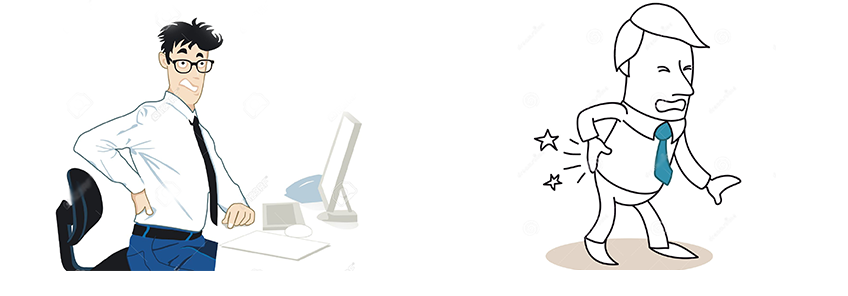Back Pain

Definition
Pain felt between the nape of the neck to the buttocks, usually in the midline, can be referred as back pain. Disease and conditions affecting the bones and muscles that constitutes the spine cause back pain. It can occur anywhere along the spine but pain in lower back is the most common location of back pain. Back pain can be felt as tight and sore muscles, sharp pain, shooting pain radiating down the leg or pain elicited during flexion or movement of spine.
Causes of back pain
- Mechanical and traumatic causes: spinal vertebral fracture or ruptured vertebral disk; prolapsed inter-vertebral disk, fractures of the spine, spondylosis; congenital anomalies.
- Inflammatory and metabolic bone diseases: arthritis (rheumatoid arthritis) and other age-related changes in spine; disease conditions of bone such as osteoarthritis (inflammation of joints), osteomyelitis (infection of bone), osteoporosis (weakening of bone due to lack of calcium), osteomalacia.
- Back muscle strains caused by excessive weight lifting, improper lifting, poor posture and lack of regular exercise
- Urinary tract problems such as hydronephrosis, renal stone, cystitis, lower urinary tract infection etc. also causes lower back pain.
- Pregnancy, postpartum period, menstruation period is the condition in which back pain usually occurs.
When to visit the doctor?
Most back pain are of short duration and resolve with home remedies and analgesics. You should seek medical advice in following conditions:
- Back pain is severe enough to impair daily living activities.
- Back pain with fever and general malaise.
- Back pain is severe, doesn’t go away after a few days, or it hurts even when you’re at rest or lying down.
- If there is weakness or numbness in the legs, or have difficulty in standing or walking.
- If control over bowels or bladder become lost, these could be signs of nerve problem or causal medical conditions that needs to be treated promptly.
Treatment options
Treatment of back pain depends on the cause. Causes of back pain are identified by various investigations such as blood test, urine test, X-ray, CT scan, MRI, etc. The goal of treatment is to relieve pain and facilitate movement.
- Non-steroid anti-inflammatory drugs such as ibuprofen, paracetamol are needed for reducing pain and inflammation. Local application of heat or ice can also reduce inflammation and pain.
- Complete bed rest is not recommended. You should continue activities as much you can tolerate. If home remedies do not work doctor can prescribe stronger analgesics.
- Hormone therapy with diet containing adequate calcium is indicated for back pain associated with osteoporosis.
- Osteomyelitis are treated with appropriate antibiotics.
- Back pain caused by urinary tract problems is treated with antibiotics and/or a surgery depending on the type and problem.
Home remedies
- Stretch out your lower back muscles by lying flat on the ground and bend your knees into your chest to stretch out your lower back muscles.
- Regular relaxation exercises can be done to reduce the back pain associated with psychological distress and fatigue.
- Massage on the back also relieves back pain by removing cramps and helps in relaxing the muscle. Massage with pain killer ointment also relieves pain.
- Take a warm bath which relieves general tension and provides relaxation. Warm water soothes cramping and tense muscles. The water’s temperature should not be more than 40oC.
- Create a comfortable sleeping environment by using a flat sheet on the bed with comfortable pillow.
- If other methods don’t help your cramps or you have lingering pain, take an over the counter medication to help alleviate the pain such as paracetamol 500 mg oral. Consult with the doctor before taking any other painkillers.
- Do not sit in a hunched position for a long time. Get up and stretch the legs in every 20-30 minutes. Maintain good posture by keeping the spine straight while seated.
- Wear low heels and comfortable shoes because high heels may create a more unstable and posture, and increase pressure on lower spine.
- Avoid standing for prolonged period especially in pregnancy and after childbirth.
- Minimize works which needs standing for long time.
- Have adequate calcium and Vitamin D in food or supplements.



Send us your feedback on this article